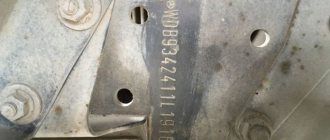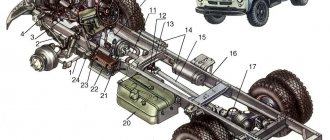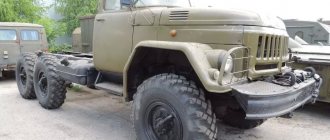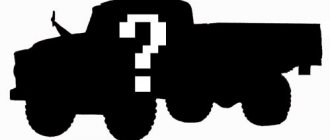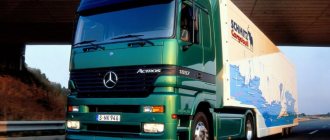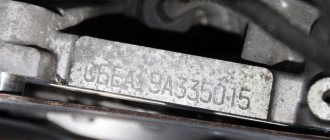- home
- Media center
- Articles
- Frame number ZIL 131
Menu
- News
- Articles
- Video materials
- Photo materials
- Publication in the media
- 3D tour
26.11.2020
You can look up the ZIL-131 frame number, where the treasured information is located, in at least several different places. Its location depends on the model and year of production of the truck. The data indicated on the frame is necessary to identify the vehicle; it is used to determine the design features of the modification of a particular vehicle.
ZIL-130 car frame and its structure
CONTENT
1 Car frame
2 Frame number ZIL-130
3 Vehicle markings
4 Frame repair
5 Repair of towing device
The frame of the ZIL-433360 car is riveted, made of stamped parts, and consists of two spars of variable channel cross-section, connected by cross members. Frame extensions and a buffer are installed in the front part of the frame (Fig. 6-1).
Frame ZIL-130
A towing device with a rubber buffer providing double-sided shock absorption and a hook with a latch for connecting to the trailer's coupling loop is mounted in the hole in the rear cross member of the frame. A towing loop is installed on the chassis of the ZIL-494560 dump truck.
About the car ZIL 130
ZIL 130 is a breakthrough of Soviet developers in the automotive industry. Dump trucks have gone through a lot of changes, especially in the 1960s and 1970s. The truck is efficient even in cramped urban environments due to its turning radius of up to 7 meters. The weight of ZIL is 4 tons. It is widely used for towing a trailer weighing no more than 8 tons.
The car is painted blue and white. Before the appearance of the ZIL 130, all enterprises producing cars worked on the production of military models. For this reason, the car had a protective paint and an alligator-type hood. The car has streamlined wings and a panoramic windshield. The cabin is equipped with a ventilation hatch and windows.
The ZIL frame number is present on every model of the legendary car. It quickly gained popularity among consumers due to its functionality and reliability. The ZIL 130 is able to drive properly in severe frosts, which gives it a huge advantage. Before the overhaul, the truck traveled 300,000 km. The successful design had a negative impact on the car, since it was not modernized for a long time. The plant developed trucks without a hood, but ZIL was not improved.
Frame number ZIL-130
Before 1991, the frame number was stamped with paint. After 91, numbers were stamped on the frame with iron padding, at the end of the frame or in front of the cabin, on the right side of the spar. Inspectors are well aware of this; their goal is to recycle all old cars. Now they are not bothering us, but as soon as it comes to registration, problems will immediately arise with registering the car. They know each model, what year and where the frame number is printed; they are taught this. You can do something with the number you painted with paint.
frame paint number
Find the place where it was applied, at least one number. Look what the font was. Type the same font on the computer, cut out a stencil with your number and apply it to the same place using white spray paint. Our task is to make it as close as possible to the factory original and the inspectors will have no questions for you. Over time, the paint will fade and look like the serial number.
ZIL frame number is filled
frame ZIL
Where else can you see the ID?
Experienced specialists know where the frame number on the ZIL-131 is, how to find it out in different ways. All data from the PTS is duplicated in the truck vehicle registration certificate. If there are no numbers indicated opposite the inscription with the chassis number, then you need to look at the body data. So they are identical. But this does not apply to all car models.
Therefore, you can also obtain information from the vehicle’s operating instructions. Often they were also painted in two different places. You can see the ID numbers on the right or left behind the gas tanks.
VEHICLE MARKING
in the summary data plate, which is mounted in the cab on the right, on the passenger seat base (Fig. 114). The letters ХТ2 at the beginning of the identification number indicate in encoded form data about the manufacturer: X - geographical area of the country; T - country; 2—manufacturer. The next six digits indicate the car model, followed by the chassis and engine number.
The Latin letter in front of the chassis number indicates the encoded year of manufacture of the vehicle.
In addition, the chassis number is painted on the right side member of the car frame, and the engine number (Fig. 115) is stamped on the upper front part of the engine cylinder block (middle line) on a horizontal area near the eye bolt. The engine model number (top line) and the year of its manufacture (bottom line) are also stamped there.
ZIL car marking
Where is the chassis number ZIL 131
MARKING OF THE ZIL-131N VEHICLE
The model, chassis number and engine number are indicated on the introductory data plate, which is mounted on the right side of the passenger seat base (Fig. 108).
The letters XTZ at the beginning of the identification number indicate in encoded form information about the manufacturer:
X—geographical area; T - country; Z—manufacturer. The next six digits indicate the car model.
In addition, the chassis number is stamped on the rear end of the right side member of the car frame, and the engine number (middle line of Fig. 109) is stamped on the horizontal area of the upper front part of the engine block near the eye bolt. Knocked out there
engine model (top line) and engine year (bottom line).
Fig. 108. Places for applying the chassis number and installing the nameplate
STORAGE AND PRESERVATION OF THE ZIL-131N CAR
Cars that are not planned to be used for a long time should be preserved in accordance with the requirements of departmental instructions for the storage and preservation of automotive equipment and property.
In the absence of departmental instructions, it is necessary to perform the following work: carry out the next maintenance;
drain the cooling system and windshield washer as indicated above;
tightly tie oiled paper around the entry points of the control levers into the unit covers, seal the gaps between the brake drums and shields with oiled paper; wrap the breather caps with insulating tape;
Unload the springs, lubricate the sheets with graphite, install the drive axles on stands, wipe the inner surface of the tires with talcum powder, bring the air pressure in the tires to normal;
charge the battery, bring the electrolyte level and density to normal, wipe dry and lubricate the terminals with technical petroleum jelly, disconnecting the battery from ground;
Clean tools, accessories and spare parts, lubricate and wrap in oiled paper;
clean off corrosion and touch up areas with damaged paint, clean unpainted metal parts and lubricate with VTV-1 and PVK grease.
During storage:
a) once every 6 months, inspect the car, remove traces of corrosion and touch up areas with damaged paint, restore the protective layer on unpainted metal surfaces of the car and on the surfaces of tools, accessories and spare parts, eliminate any defects noticed?
b) once a year, fill the engine cylinders with oil in the order indicated above
When removing for storage, remove preservative materials and carry out EO lubricant.
Source
Frame repair
When repairing frames, it is necessary to check the tightness of the rivet joints, the presence of cracks in the flanges of the side members and cross members, as well as possible deflection and skew of the side members. Below are recommendations for correcting faults found on frames.
Rivet joints are checked by tapping with a hammer. Loose (rattling) rivets should be replaced. Tightening loose rivets has no effect. Worn holes should be drilled to accommodate the increased diameter of the rivet. If the holes for the rivets are heavily worn (more than 15% of the nominal diameter), the holes can be welded and re-drilled, and then strengthened by running a conical punch through them.
The rivets must fit tightly into their holes. If there is a displacement of the mating parts or if the diameter of the holes in them is different, the holes should be drilled or reamed. The mating parts of the frame must be pressed tightly against each other, since the presence of a gap will allow the body of the rivet being pressed to fill this gap, forming a so-called “blind” washer. If there are difficulties, you should eliminate the gap, using the hole located nearby, tighten the mating parts with a bolt and nut or clamps, and only then carry out riveting.
Frame drawing
ZIL-130 frame drawing
In garage conditions, it is recommended to use hot riveting, that is, heating the rivets in electric or other heating ovens. After cooling, a hot rivet will tighten the mating parts even more tightly. At auto repair plants, preference should be given to hydroriveting using cold rivets. In order not to violate the established position of the parts, replacement of rivets should be done sequentially, that is, first cut off one rivet, install a new one in its place, then cut off the next one, etc.
After riveting, the rivet heads must be correctly positioned (along the axis of the rivet), fully compressed and must have a geometrically correct shape without distortions, sagging or cracks. The diameter of the newly formed rivet head must be at least 1.5 times the diameter of the rod. Riveted joints must ensure a tight fit of the surfaces of the parts being connected over a diameter equal to two diameters of the rivet rod. It is possible to replace the cut rivet with a bolt with a spring washer and a nut.
Deflections and distortions. Determined by inspection, as well as checking using rulers and templates. The curvature of the side members in the plane of the vertical wall should not exceed 2 mm over a wild 1000 mm or 5 mm over the entire length of the spar. Bent frame parts are straightened in a cold state.
What's new in the legislation on frame numbers and vehicle registration
Owners of trucks whose frame number ZIL 131 is rusty and difficult to read must apply additional markings, the so-called police markings. This obligation is imposed by a separate law. This procedure allows you to simplify transactions with problem trucks, tractors and other vehicles.
When registering a car, the inspector checks the ZIL-131 frame number carefully. If it is rusty, a report will be drawn up indicating that there are signs of changes in the markings. After this, an inspection is scheduled and will be performed by a forensic expert.
Based on the issued conclusion, a decision will be made to initiate or refuse a criminal case. Only after this the owner can register the car. Vehicles that were stolen and returned to the owner with already changed license plates are registered using an identical scheme.
Car registration rules often change, are supplemented, and are improved, so it is better to find out about the latest accurate data from the relevant government agencies. Recently, the Supreme Court refused to change the rules for registering cars with rusty registration plates.
Car history
Since 1962, the Likhachev Plant in Moscow has produced a truck for the national economy under the ZIL-130 brand. The truck was extremely popular and practical, but was inferior to its classmates due to high fuel consumption. At the end of the seventies, the plant began developing a more economical model with a diesel engine. Namely, in the 70s, the designers of the Likhachev plant received the task of developing two advanced trucks with different load capacities.
ZIL-4331
The models were supposed to run on diesel fuel. Initially, the car was designed by ZIL specialists, but after the design was created, the documentation was transferred to Naberezhnye Chelny. In 1986, the first ZIL-4331 began to roll off the assembly line. It was this model that was intended to replace the ZIL-130. Shortly after the launch of the project, the debut version of this model with a double cab was presented, as well as a chassis designed for special vehicles. Later, specialists from the Likhachev plant created a racing version of the truck, which resembled the original only in appearance.
Cabin and body
First of all, the appearance of the cabin has changed. It acquired angular, clearly defined outlines without smooth transitions. The body is made entirely of metal and has a common base. However, its layout is not entirely standard. The main difference is that the fenders, hood and front grille are made from one rigid piece. Access to the engine is provided by lifting this structure up and forward on hinges that are attached to the front bumper on the vehicle's power frame. At the same time, it has become very convenient to repair the engine; access to all engine systems is available. Over time, this method was abolished due to some inconveniences in operation.
Photo of ZIL-4331
In subsequent versions of the model, the hood opens in the usual “alligator” way. At the front of the ZIL-4331 truck, a new front bumper is installed, into which headlights and turn signals are mounted. Moreover, they are structurally located in such a way that there is the least danger of damage in the event of an accidental collision. Inside, the cabin has become more comfortable. The comfortable driver's seat is sprung and adjustable in all directions. Two passengers can sit side by side. The middle seat lifts up to create a table. The large glass area of the cabin and side mirrors allow you to fully control the road situation. The ZIL cabin of the “4331” model is equipped with excellent heat and sound insulation, which allows you to talk inside the truck without raising your voice, and also not experience inconvenience due to cold weather. There are three seats, one of them is the driver's seat. One of the most popular was the modification with a berth, which appeared in the early 90s.
Onboard ZIL-4331
The model received a universal bumper “skirt”, fairings on the sides of the body and a drag foiler installed on the roof. ZIL-4331, in comparison with foreign analogues, stood out for its significantly lower cost. In addition to the cabin designed for three people, versions with a 2-row cabin version with 7 seats were also produced. The ZIL-4331 flatbed body is a wooden platform with metal transverse base bars, with folding rear and side sides. The body design provides for the possibility of installing extension sides and an awning with a frame.
Specifications
Engine
It is ZIL-4331 that is considered the founder of the first Russian line of trucks with diesel power plants. Fuel consumption of ZIL 4331 is from 18 l/100 kilometers. If we talk about a road train, then its consumption already starts from 25 liters per hundred. It is extremely rare, but still, you can find gasoline engines on trucks of the “4331” model.
When operating a car with gasoline engines, consumption is approximately 30-36 liters per 100 km at a speed of 90-95 km/h and may vary depending on the load. Specifications
| Engine | ZIL-645 | ZIL-508.10 | ZIL-508.300 |
| Number of cylinders | 8 | 8 | 8 |
| Number of valves | 16 | 16 | 16 |
| Cylinder arrangement | Longitudinal V-shaped at an angle of 90° | Longitudinal V-shaped at an angle of 90° | Longitudinal V-shaped at an angle of 90° |
| Volume | 8.74 liters | 6 liters | 6 liters |
| Power | 185 l. With. | 150 l. With. | 135 l. With. |
| Maximum speed | 2,800 rpm | 2,800 rpm | 2,000 rpm |
| Maximum torque | 510 Newton meters | 402 Newton meters | 377 Newton meters |
| Dimensions | |||
| Length | 6 370 mm | ||
| Width | 2,500 mm | ||
| Height | 2,655 mm | ||
| Wheelbase | 4,500 mm | ||
| Front track | 1,930 mm | ||
| Rear track | 1 850 mm | ||
| Clearance | 330 mm | ||
| Dimensions of wheels | 7.0-20 | ||
| Wheel type | 9.00R20; I-N142B-1 | ||
| Weight characteristics | |||
| Truck weight | 4,820 kg | ||
| Maximum load capacity | 6 tons | ||
| Weight fully equipped and max. loaded | 11,700 kg | ||
| Weight of one fully equipped wheel | 93 kg | ||
| Engine weight | 720 kg | ||
| Engine weight with all equipment | 960 kg | ||
| Weight of the entire cabin structure | 550 kg | ||
| Maximum load | To the front axle | 3,735 kg | |
| To the rear axle | 8,005 kg | ||
| When using a road train with full suspension | 23,000 kg | ||
| Transmission | |||
| Type | Mechanics | ||
| Number of gearbox stages | 5 | ||
Transmission
The truck is equipped with rear axle drive. It has a single-plate clutch with peripheral springs. We also note that the clutch release drive is equipped with a pneumohydraulic booster.
Chassis
In the front part of the ZIL 4331 there is a pair of semi-elliptical springs with two shock absorbers and sliding rear ends. But at the rear, two main and additional springs of the same type are used.
Modifications
- ZIL-433100 - basic model with a wheelbase of 4500 mm and a ZIL-645 engine;
- ZIL-433102 – standard chassis;
- ZIL-433104 – chassis for fire trucks;
- ATs-3-40(433104) and ATs-40(433362)-63B.01 – fire tankers;
- ZIL-433110 – basic modification with the ZIL-508.10 unit;
- ZIL-433116 – basic version with the ZIL-509.10 power plant;
- ZIL-43314B - long-wheelbase flatbed version with a ZIL-6454 engine with a wheelbase of 6100 mm;
- ZIL-4332A - a special version with an extended wheelbase (5600 mm) and a ZIL-645 engine;
- ZIL-4333 - short-wheelbase modification with a ZIL-645 engine and a wheelbase of 3800 mm;
- ZIL-433302 – short-wheelbase chassis;
- ZIL-433360 – model with a shortened wheelbase and the ZIL-508.10 power plant;
- ZIL-433362 - short-wheelbase chassis equipped with a ZIL-508.300 engine;
- ZIL-442100 – truck tractor with a wheelbase of 3800 mm and a ZIL-645 unit;
- ZIL-442160 – truck tractor with a wheelbase of 3300 mm and a ZIL-508.10 engine;
- ZIL-442300 is a truck tractor with a sleeper and an extended wheelbase (4500 mm).
All versions of the model were characterized by a rear-wheel drive, front-engine layout.
The most popular modification
We are talking about ZIL-4333. The shortened base was produced in the form of a truck and was equipped with three different engines: ZIL-645; ZIL-508.10 and ZIL-508.300. Certain changes added a prefix to the main index.
Advantages and disadvantages
- The main advantages of the ZIL-4331 vehicle are excellent maneuverability and impressive load capacity.
- A reduced number of chassis lubrication points and automatic brake adjustment help reduce time and money spent on service work.
- Today, ZIL-645 engines are no longer produced, but it is quite possible to purchase spare parts for engine repair at fairly reasonable prices.
- The plumage of the first copies of the ZIL-4331 was integral. For this reason, if the truck frame became skewed, problems arose with closing the hood.
- Good interior seal.
- The presence of seat belts on all seats.
Despite excellent reviews and a lot of positive aspects, this model is not popular in Russia. Thus, this truck cannot seriously compete with foreign analogues due to its rather high fuel consumption and low load capacity. But the ease of repair and low cost make the car in question extremely popular in some areas of industry.
Let's sum it up
Having completed production of ZIL-4331 in 2004, the manufacturer did not leave the car without a means of subsistence. Thanks to this, the truck remains popular due to its ease of maintenance. Of course, the power units are quite uneconomical and the load capacity is relatively small, but this does not prevent the car from still being popular in many areas.
Fuel truck ZIL-4331
When purchasing this model, you will have to fork out an amount of 200 to 2500 thousand rubles. In this case, the buyer receives a version produced in 1995-2004 with low mileage and in excellent condition. All that remains is to ensure quality care and use all the positive aspects of this car.
We advise you to read the article: ZIL - the history of the auto giant
Frame number zil 4331 photo
You are interested in: Frame number zil 4331 photo . (Photos on this topic are collected here, but relevance is not guaranteed.) If you find that any photo violates copyright or is inappropriate, please notify us ( [email protected] ).
Extension of base and frame. | Page 5 | Forum ZIL 131/130/133/4331 source
Conversion of flatbed ZIL 4331 into a dump truck | Fermer.Ru - Farmer.Ru. source
Scale models of cars - Domestic - Trucks - tractors. source
forum Truckers Trucking u2022 View topic - ZIL, where is the number. source
forum Truckers Trucking u2022 View topic - ZIL, where is the number . source
Prices for MAZ spare parts from other manufacturers: Cross member ZIL source
Choice of ZIL 43. | Forum ZIL 131/ source
Frame repair. — Page 4 source
Ukragrozapchast: Bridges. Frame source
Entirely for spare parts ZIL 4331 Kherson. Dismantling ZIL 4331 Kherson source
Zil 1995
auto truck 4 years old license plate
the rear one was completely rusty ((was behind) the front part.
Modifications of the ZIL-131 car
The car was produced under the abbreviation ZIL-131 from 1966 to 1986. Until 2002, other modifications rolled off the assembly line. For example, ZIL 131N was manufactured without a platform. It was possible to install different types of bodies and installations on it. The models were produced at two factories located in Moscow and the Urals.
ZIL 131NA was distinguished by the fact that it was produced with unshielded and unsealed electrical equipment. This brand of truck was widely used for military and commercial purposes. Models ZIL-131NS and ZIL-131NAS were produced in the HL version, intended for cold climates, and operated at temperatures down to -60°C.
Main modifications of the truck:
- ZIL 131;
- ZIL 131NA and N;
- ZIL 131NS and US.
There have been many modifications released over the years. Therefore, the chassis number is sometimes difficult to find. The numbers applied with paint naturally became invisible over time, after just a few years. They disappeared especially quickly if the car was poorly maintained and they were not redrawn annually. You can see the frame number ZIL 131, where the photos posted on the site are located, in detail and detail.
